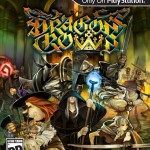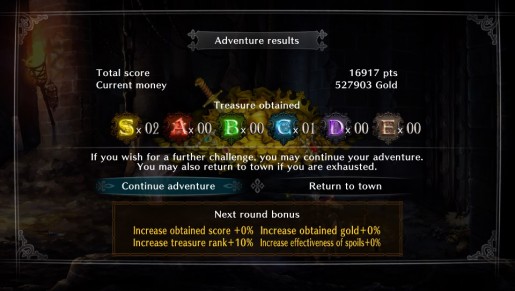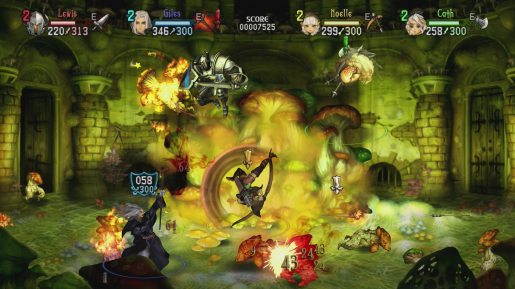As an added challenge for those players with more loot than they know what to do with, there’s a sort of campaign mode that links the stages together for a longer playthrough. Completing the stages in order and continuing onto the next will unlock an ongoing set of bonuses after each stage. Gold, experience points/score, and quality of loot all have a chance to be increased as you unlock more multipliers. It’s not uncommon to finish up even a small handful of stages in one run and leave with at least five levels and a few dozen weapons to pick through. A word of caution: equipment durability and potions will not be replenished between stages, so it’s always handy to bring along a few extra bags worth of backup equipment.
NOT
Initially inaccessible multiplayer
For those looking to enjoy Dragon’s Crown from the comfort of the same room need not worry about this section. Local co-op play is available on the PS3 version straight out of the character creation screen. However, online multiplayer is a different story entirely. Players will have to unravel the mystery surrounding the dragon’s crown and finish all nine stages before an option for multiplayer is unlocked. This serves as a double-edged sword: it gives players a chance to grasp the controls of the game and prevents any unintentional spoiling of the story while at the same time limiting players from joining their friends right out of the box. My only complaint is that any additional characters the player makes will also have to beat the game in order to unlock online play for each character, though there is a reason for that in the story that you’ll just have to play to find out.
Borderline graphic in detail
One of the more common objections to the art style of Dragon’s Crown is the hypersexualization of a few key characters. I, for one, welcome the inclusion of these character traits. Each of the six playable characters, as well as many of the primary non-player characters, have character traits that seem almost comical with their emphasis. The stalwart warrior is accentuated with oversized armor despite his otherwise meager frame, while the dwarf is purely muscles hidden behind a manly beard. With the exception of the elf and npc princess, many of the female characters have a heavy emphasis on their chest. If there’s anything to be critical of in Dragon’s Crown, it’s the future back problems that could plague the buxom sorceress.
Magically overwhelmed
Every brawler on the market runs the risk of hitting a moment where the game just gets overloaded with action and has to slow down to process it all. Sadly, Dragon’s Crown is no exception to this rule. It’s not the four players on screen or the massive deluge of attacks and numbers that can overwhelm the game, but rather the overuse in spellcasting. One wizard or sorceress can usually make it through just fine, but when you run a full party of them through a dungeon, things can get pretty dicey once those full-screen blizzards come around. Not once did the game lock up or freeze during these heavy magic sessions, but the framerates did occasionally dip down pretty low. This is an issue that seemed to pop up more during the PSVita version of Dragon’s Crown than on the PS3.
As Dragon’s Crown only recently was released in Japan, many of the players I encountered during my review were from overseas. The connections were for the most part quite stable, but there were occasionally times when I would run into moments of lag, sometimes lasting an entire dungeon. I’m not talking the freezing or dropping framerates before, but rather a constant latency drop. Combat would flow at its usual pace, but all of my inputs would be delayed by anywhere up to half a second. Granted this didn’t happen frequently enough to be much of an issue, but it did occur more often on the Vita.
VERDICT
 Dragon’s Crown represents one of the finest action RPGs released in the current age of gaming. With its roots based upon the old Capcom machines of the early ’90s, there’s plenty of solid gameplay meshed perfectly with all of the conventions of a modern day role-playing game. While the occasional technical hiccup or bit of bare skin might put some consumers off, there’s little else that mars an otherwise picture-perfect game.
Dragon’s Crown represents one of the finest action RPGs released in the current age of gaming. With its roots based upon the old Capcom machines of the early ’90s, there’s plenty of solid gameplay meshed perfectly with all of the conventions of a modern day role-playing game. While the occasional technical hiccup or bit of bare skin might put some consumers off, there’s little else that mars an otherwise picture-perfect game.
[Editor’s Note: Dragon’s Crown was reviewed on the PSVita platform. The game was provided to us by the publisher for review purposes.]





I’m a game developer, specifically a character artist- Your first line is fairly offensive to those of us who actually make games and shows either a disregard or lack of understanding of how the products you’re reviewing are made.
I understand the point was to laud Vanillaware for producing hand drawn 2D art, but to immediately discredit all of the other genres of games as having “computer generated” graphics. Child, please!
Here’s an amazing fact- Even Dragon Crown’s graphics were made on a computer. Beyond that, all art made for games on a computer is HUMAN generated. There’s not automagic button that instantly sculpts, textures or animates the things you see in your games. There’s a lot of hand drawn work from concept artists that goes into 3D games. Nearly every model in every game is hand sculpted by someone (scans notwithstanding, which are rare). And the items that aren’t done by hand must still be tweaked. Motion capture data for animation, for instance, does not immediately transition into a game without a skilled animator to refine and implement it.
In the future, I think your readership would appreciate you complimenting a game on it’s merits without having to slap down the rest of the industry. That goes for whether you are educated on how things or done or not.
You sound like a nitwit, Zim.
Zim get over yourself and get off your pedestal.